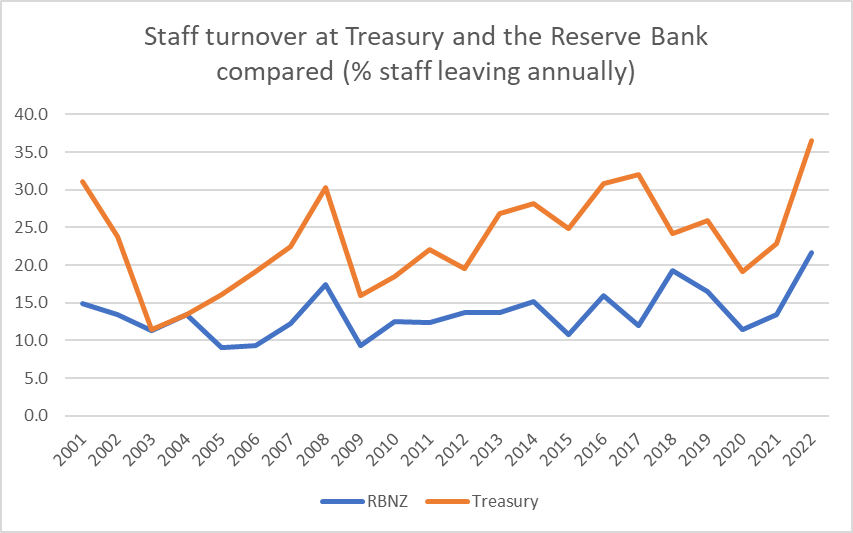Over the last couple of years I’ve commented at various times on (a) the loss of experienced research staff (b) the rapid turnover of senior managers, and (c) the bloated number of (very highly paid) new senior managers at the Reserve Bank.
I haven’t paid overly much attention to the overall staff turnover data. And it turns out that was probably just as well.
Here is a chart of annual staff turnover rates for the Bank this century. There has been a sharp increase in the last year (to June 2022).

But Simon Chapple, at Victoria University’s Institute for Governance and Policy Studies, went to the effort of digging out the same data for the Bank and a bunch of other public sector agencies, and kindly sent me a copy of his spreadsheet.
Of all the other public sector agencies, perhaps the best comparator is The Treasury. They are very different agencies but have often been bracketed together.

There is a lot more variability in the Treasury series, but (a) it has been higher or no lower than the Bank every year this century, and (b) over the last year has had an absolutely staggering 36.5 per cent turnover rate. It was bringing to mind the stories from 35 years ago when at one point (and if I recall correctly) the median length of service at The Treasury was under two years.
Here is the data for three other agencies: the (public service) Department of Prime Minister and Cabinet, the Public Service Commission (previously SSC), and Statistics New Zealand.

I suspect the DPMC figures can be discounted, as DPMC built up a huge temporary operation to co-ordinate the Covid response (including lots of comms staff for all those adverts), but in the most recent year even SNZ had slightly higher staff turnover than the Reserve Bank. (For the public service as a whole – not shown – the staff turnover rate was exactly the same as at the Reserve Bank.)
Over the last year or so, presumably two – mutually reinforcing – influences have been at work. First, the economy has been materially overheated reflected, among other places, in an extremely tight labour market. When the opportunities are good and finding new jobs is easy a given person is more likely to move in any particular year. And the second is the rather arbitrary block on wage increases for many public servants. All else equal, not only has that made moving to the private sector relatively more attractive – private sector wage increases have run well ahead of public sector ones – but has also created the readily-visible bizarre incentive that the only way many public servants can get a pay rise is to change jobs (whether to other positions in the private sector or elsewhere in the public sector), perhaps with some grade inflation thrown in (people who aren’t really senior or principal analyst material getting given those titles and salaries). Moving simply because it is the only way to get a pay rise – in a generally overheated labour market – makes sense for the individual, but almost certainly does not for the public sector as a whole.
(And here I am not entering into questions of whether public sector salaries are generally too high (or not) or the size of the public sector: issues for other people on another day.)
Zero staff turnover would generally not be desirable. When I used to pay more attention to these things at the Bank we used to be told that for established well-run professional organisations a 10-15 per cent annual turnover rate was fairly normal (perhaps coincidentally that was the rate the Bank tended to have). I find it harder to believe that 25-30 per cent annual turnover rates – as at The Treasury – is entirely healthy, no matter how much you might encourage rotation, fresh opportunities etc. But one would have to hope that the 2022 turnover rates for all these public sector agencies prove to be peaks, and that by the 2023 and (especially) 2024 annual reports, staff turnover has settled back to much more normal levels for organisations of this sort. Whatever your view of the appropriate size of government, what agencies we do need need capable and experienced staff.